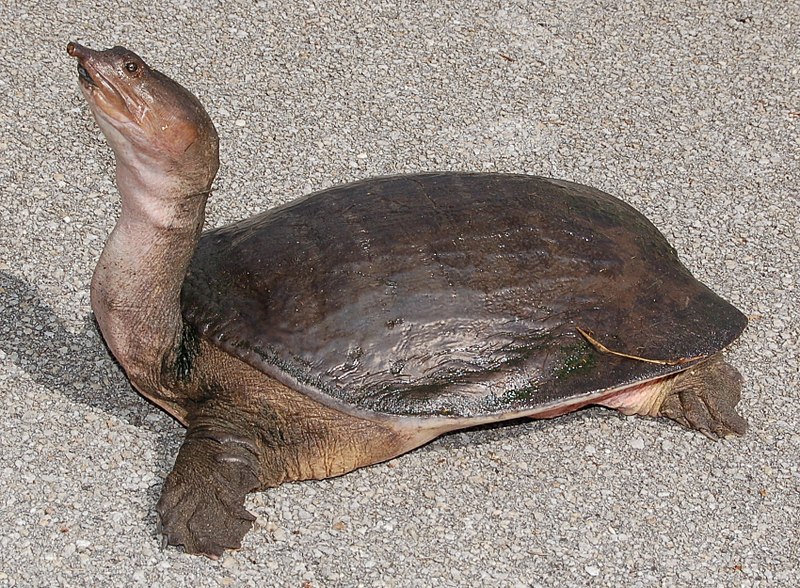 Softshell Turtles caught my attention early and remain great favorites of mine all these years (decades!) later. I’ve had a long history with the group – I raised Smooth Softshell hatchlings as a child, dove with huge Florida Softshells in southern canals and was eventually lucky enough to work with the immense Narrow-Headed and Bibron’s Giant Softshells. Today I’d like to introduce this most unique turtle family. Read More »
Softshell Turtles caught my attention early and remain great favorites of mine all these years (decades!) later. I’ve had a long history with the group – I raised Smooth Softshell hatchlings as a child, dove with huge Florida Softshells in southern canals and was eventually lucky enough to work with the immense Narrow-Headed and Bibron’s Giant Softshells. Today I’d like to introduce this most unique turtle family. Read More »
Yearly Archives: 2010
Snake Surprise – “Virgin” Female Boa Constrictor Gives Birth
 A female Boa (Boa constrictor) shocked herpetologists by giving birth to live young that she produced by cloning rather than mating. What’s more, the process used to create the young is new to the animal world – it has not been seen in any other vertebrate.
A female Boa (Boa constrictor) shocked herpetologists by giving birth to live young that she produced by cloning rather than mating. What’s more, the process used to create the young is new to the animal world – it has not been seen in any other vertebrate.
Asexual Births in other Species
Asexual reproduction or parthenogenesis – producing young without mating – is well known among insects and certain fishes (including Hammerhead Sharks), some of which can even switch sexes several times. It has also been recorded in a small number of reptiles, such as the Brahminy Blind Snake, American Whiptail Lizards and the Komodo Dragon. Read More »
New Dinosaur Resembled a Horned Lizard – On an Immense Scale
Horned Lizards (Phrynosoma spp., please see photo) and odd Australia’s Thorny Devil (Moloch horridus) have always reminded me of dinosaurs – I think it was their horn-bearing skulls. I recall sketching my pet Horned Lizards and taking the (somewhat primitive!) drawings to the American Museum of Natural History for comparisons with the Triceratops skeletons displayed there. This month (September, 2010), fans of such reptiles and dinosaurs were pleased to learn of the discovery of 2 new dinosaur species, one of which bore 15 horns upon its head – more than any other animal, past or present.
North America’s Lost Continent
The new species were uncovered in the Grand Staircase-Escalante National Monument, southern Utah, USA. The area lies in what was once the “lost continent” of Laramidia, formed when an ancient sea separated the eastern and western portions of North America for millions of years. The enforced isolation gave rise to innumerable bizarre insects, fishes, amphibians, dinosaurs and other creatures, many of which, it appears, have yet to be discovered. Read More »
Beyond Webs – Swimming, Spitting and Other Spider Hunting Methods – Part 2
 Please see Part 1 of this article for a look at the unique hunting techniques employed by Fishing, Trap Door and other spiders.
Please see Part 1 of this article for a look at the unique hunting techniques employed by Fishing, Trap Door and other spiders.
Orb Webs
I’ve been avoiding “traditional spiders”, but wanted to include an observation I made over 20 years ago in Costa Rica. I was tossing katydids into the huge orb webs that were abundant near my research station. The web-owners (Nephila spp.) wrapped the insects in silk and then administered a bite. Then I offered lubber grasshoppers – the same size and shape as the katydids, but equipped with immensely powerful rear legs. On several trials, the spiders first pulled off the grasshoppers’ rear legs, then wrapped and bit the insects. I imagine they were attempting to limit damage to the web. Read More »
Preparing Your Amphibian and Reptile Collection for Autumn and Winter
 Autumn’s arrival in the Northern Hemisphere brings both opportunities for improving your pets’ health and behavioral changes in many animals.
Autumn’s arrival in the Northern Hemisphere brings both opportunities for improving your pets’ health and behavioral changes in many animals.
Seasonal Behavioral Changes
Many species, even those from regions considered “tropical”, slow down during the cooler seasons; in captivity they often respond to autumn’s arrival in a similar manner. Animals that are native to your area will be most strongly affected, especially if exposed to the local light cycle, but even exotic species may gear their behavior to local conditions. Read More »
 That Reptile Blog – Reptile, Amphibian and Exotic Pet Care and Information
That Reptile Blog – Reptile, Amphibian and Exotic Pet Care and Information
